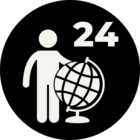Hi,
Faced with having to handle multiple large datasets (5M+ features), I'm looking into whether I can improve performance. I just had one of these dataset crash after 12 hours !
The task is matching any source data set (only) spatially with a data set of buffered municipalities, and so there are no common attributes. I.e., no possible values for "Group By". Any source feature could possibly end of in any number of municipalities.
Is it possible to get a performance boost under these circumstances ? And if so, how ?
Cheers
















